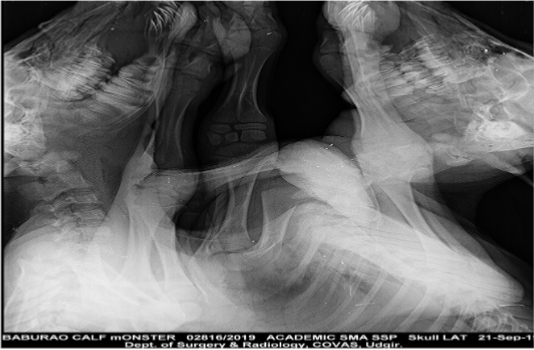A dicephalus tetrabrachius thoracophagus tetrapus dicaudatus conjoined monster calf in Marathawadi buffalo: A case report
DOI:
https://doi.org/10.56825/bufbu.2023.4213920Keywords:
Bubalus bubalis, buffaloes, dystocia, dicephalus, tetrabrachius, conjoined monster, pelvimetryAbstract
Fetal anomalies and monstrosities are the most common cause of dystocia in bovines. Conjoined twins are usually monozygotic in origin and occur due to incomplete division of one embryo into two at the primitive streak of the developmental stage depending upon the site of fusion or non-separation. Reports on such anomalies in buffalo seem to be meager. A rare case of dystocia due to dicephalus, tetrabrachius, thoracophagus, tetrapus, dicaudatus, conjoined female calf was resolved with the use of six-way traction by considering the internal pelvimetry.
Downloads
Download data is not yet available.
Metrics
Metrics Loading ...
References
Bhoi, D.B. 2009. Conjoined Sternopagus twin monster: A cause of dystocia in Mehsani buffalo. Vet. World, 2(8): 327. Available on: http://www.veterinaryworld.org/Vol.2/August/Conjoined%20Sternopagus%20Twin%20monster%20%20A%20cause%20of%20Dystocia%20in%20M.pdf
Fernando, A. 1993. Practical Guide to High Risk Pregnancy and Delivery, 2nd ed. Baltimore, Maryland, USA. 50-68.
Noden, D.M. and D.A. Lathunta. 1985. The Embryology of Domestic Animals. Wiliams and Wilikins, Baltimore, Maryland, USA. 376.
Sachan, V., B. Kumar, V. Sonkar and A. Saxena. 2016. Monocephalic Thoracopagus tetrabrachius tetrapus monster in Murrah buffalo. 35(1): 23-26.
Singh, G., A.K. Pandey, R. Dutt, S. Sundar, S. Kumar. and S. Chander. 2013. Delivery of a Dicephalus Sternopagus Tetrabrachius tetrapus dicaudatus monster in Murrah buffaloes. Buffalo Bull., 32(4): 242-244. Available on: https://kukrdb.lib.ku.ac.th/journal/BuffaloBulletin/search_detail/result/286433
Roberts, S.J. 1971. Veterinary Obstetrics and Genital Disease (Theriogenology), 2nd ed. GBS Publisher and Distributor, Delhi, India. 73.
Fernando, A. 1993. Practical Guide to High Risk Pregnancy and Delivery, 2nd ed. Baltimore, Maryland, USA. 50-68.
Noden, D.M. and D.A. Lathunta. 1985. The Embryology of Domestic Animals. Wiliams and Wilikins, Baltimore, Maryland, USA. 376.
Sachan, V., B. Kumar, V. Sonkar and A. Saxena. 2016. Monocephalic Thoracopagus tetrabrachius tetrapus monster in Murrah buffalo. 35(1): 23-26.
Singh, G., A.K. Pandey, R. Dutt, S. Sundar, S. Kumar. and S. Chander. 2013. Delivery of a Dicephalus Sternopagus Tetrabrachius tetrapus dicaudatus monster in Murrah buffaloes. Buffalo Bull., 32(4): 242-244. Available on: https://kukrdb.lib.ku.ac.th/journal/BuffaloBulletin/search_detail/result/286433
Roberts, S.J. 1971. Veterinary Obstetrics and Genital Disease (Theriogenology), 2nd ed. GBS Publisher and Distributor, Delhi, India. 73.

Downloads
Published
2023-03-31
How to Cite
Ramteke, S. S., Razzaque, W. A. A., Agivale, S. M., & Alai, R. V. (2023). A dicephalus tetrabrachius thoracophagus tetrapus dicaudatus conjoined monster calf in Marathawadi buffalo: A case report. Buffalo Bulletin, 42(1), 51–56. https://doi.org/10.56825/bufbu.2023.4213920
Issue
Section
Case Report








.png)








